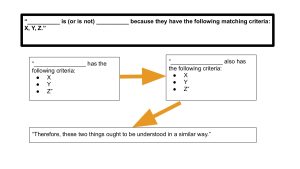11
Key Concept
Definition Argument: argues that a term or concept ought to be understood–that it ought to be defined–in a certain way and according to a certain set of criteria.

How terms are defined can be critical to an arguer’s point. Indeed, an argument can sometimes hinge on how the audience understands a particular term that is central to an arguer’s stance.
And definition arguments can appear in virtually every rhetorical situation imaginable. When we were kids, for example, our parents probably outlined a clear argument for how the term “bed time” was defined. (“Bed time is 9:00 pm on the dot, whether or not you’ve finished playing your video game!”)
And in less mundane instances–like in legal arguments–a term’s definition can have very serious implications, like the distinctions between some of the following, related terms:
- Homicide: killing another person, legally or illegally, for justified or unjustified reasons. By a strict definition, soldiers on a battlefield can commit homicide, so too can someone who intentionally or unintentionally kills someone out of self defense
- Murder: an intentional, illegal act involving malice, forethought, and planning.
- Manslaughter: a less intentional act, not involving a high degree of forethought or deliberateness, and while the outcome is still fatal, the act itself may not overtly involve malice or the intention to kill.
In a broad sense, all three terms involve one person killing another, but there are a wide number of contextual elements related to the person’s actions that must be defined.
Or, consider the distinctions between these legal terms:
- Unlawful Possession of a Weapon: this is used to define someone who is illegally in ownership of a weapon; perhaps, for example, they have a gun, but don’t have a permit. Or maybe they have a brick (which could be used as a weapon) but they aren’t a mason; maybe they have an aluminum baseball bat (which, again, could be used as a weapon), but they aren’t a Little League coach. In this case, regardless of the person’s intent, they have broken the law. Note that in the case of the brick and the baseball bat, however, unless the person has committed a crime with those items, it’s difficult to define those items as weapons since they can both serve many other purposes, whereas in the case of the firearm, it’s much easier to define the item as a weapon. What’s important to remember, however, is that how we’re defining certain terms is really important.
- Possession of a Weapon for an Unlawful Purpose: this is used for an instance where someone does legally own a weapon, but they have planned on using it (or have used it) in an unlawful way. For example, perhaps someone legally owns a firearm (and, therefore, isn’t guilty of “Unlawful Possession of a Weapon”), but they use that firearm to rob a convenience store. In this case, they could be found guilty of Possession of a Weapon for an Unlawful Purpose. Or, maybe someone who has an aluminum bat in their car is a Little League coach, but they use that bat to smash the windows of their neighbor’s house, thereby committing vandalism and using that bat for an unlawful purpose.
In all the above cases, however, how a person’s intentions are defined is critical.
Or perhaps, someone can attempt to discredit a particular news organization by categorizing it–by defining it–as “fake news.” Remember, however, that an argument is only sound if the arguer provides appropriate evidence to support their claim, so if one were to define a news organization as a purveyor of “fake news,” it’s incumbent on that person to provide evidence of faulty, inaccurate reporting by that news organization. Indeed, without evidence, an argument doesn’t hold water.
Of course, definition arguments don’t necessarily have to appear in highly consequential situations; consider the following clip where the comedian Pete Holmes argues that traffic (often thought of as the textbook example of a frustrating event to avoid at all costs) ought to be understood–ought to be defined–to be a positive experience.
For our purposes, however, here are some of the ways we could consider making definition arguments:
1) We can identify an important, but potentially disputed term within our subject, and argue for the adoption of a specific definition of it. In this approach, we would explain what is at stake (i.e., the consequences of different definitions), and offer examples or cases to support our argument. This approach focuses on the criteria of a category. An example is the term “consent” used in part for classifying actions as sexual assault.
2) We can identify a controversial case where the status of a person or thing within an important category is debatable. This approach focuses more on whether or not a specific phenomenon is a “match” for the criteria of a category, but it likely will mean interpreting those criteria. An example of this would be whether or not putting a child in beauty pageants constitutes “child abuse.”
3) We can argue that a condition exists, by defining the terms of it. This approach focuses on establishing a set of facts and using them shepherd our audience toward seeing that a condition is real, palpable, and undeniable. An example would be pointing to a series of phenomena to argue that a student loan crisis exists and that the phenomena ought to be defined as a “crisis.” Another example would be to argue that there is an opioid epidemic: an arguer could point to a series of phenomena to arguer that they comprise the existence of an “epidemic.”
Recapping the main ideas behind Definition Arguments:
- Argue that a term ought to be defined in a certain way
- In some cases can argue that a condition exists, by defining that condition’s existence
